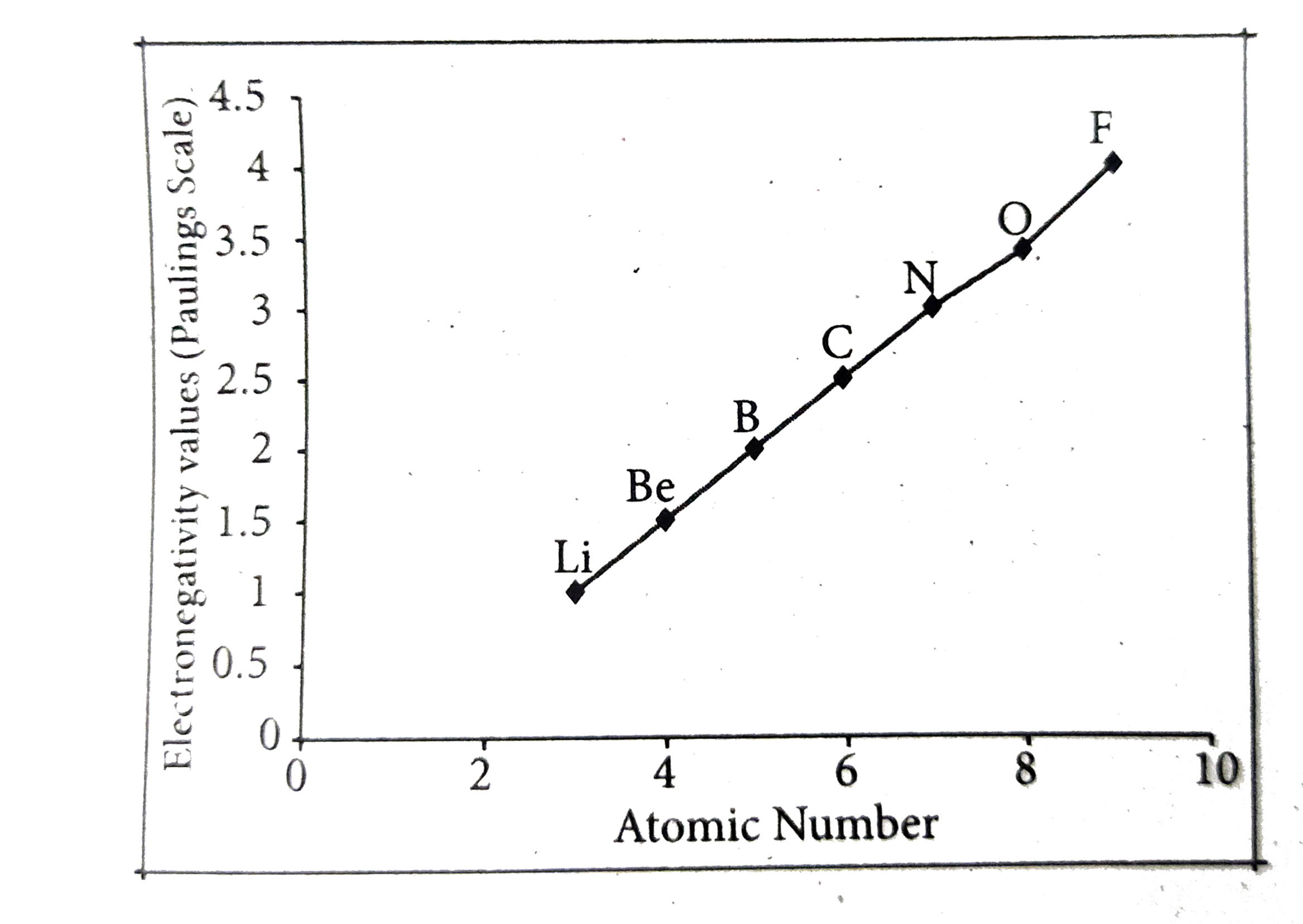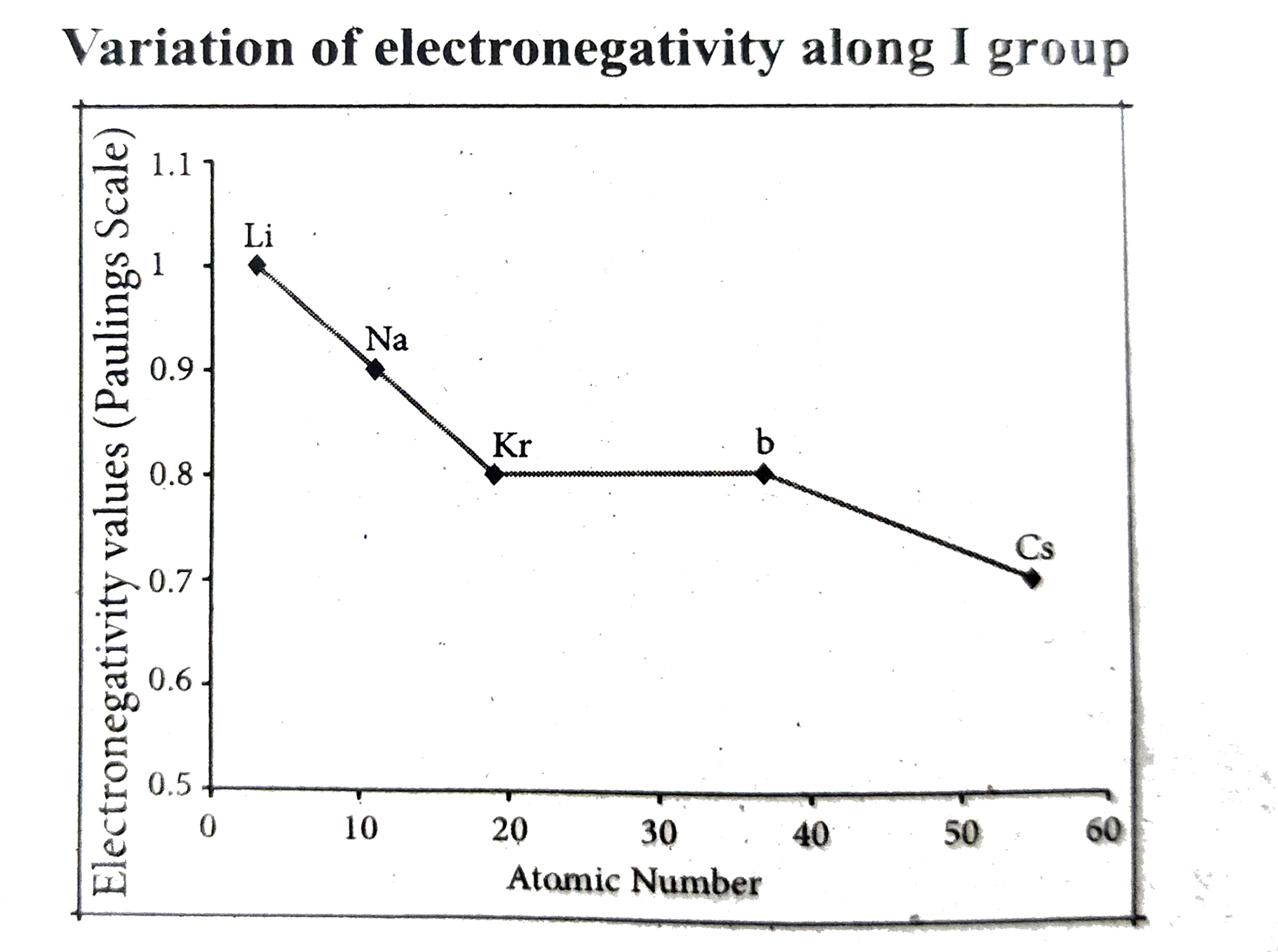(i) State the trends in the variation of electronegativity in period and group.
(ii) The electron gain enthalpy of chlorine is 348 kJ mol−1. How much energy in kJ is released when 17.5 g of chlorine is completely converted into Cl− ions in the gaseous state ?
(i) Variation of electronegativity in a period : The electronegativity increases across a period from left to right. Since the atomic radius decreases in period, the attraction between the valence electron and the nucleus increases. Hence the tendency to attract shared pair of electrons increases. Therefore, electronegativety increases in a period.
 Variation of electronegativity in a group : The electronegativity decreases down force on the valence electron decreases. Hence electronegativity decreases in a group.
Variation of electronegativity in a group : The electronegativity decreases down force on the valence electron decreases. Hence electronegativity decreases in a group.

(ii) Cl(g)+e−→Cl−(g)ΔH=348 kJ mol−1
for one mole (35.5g) 348 kJ is released.
∴ For 17.5g chlorine (348" kJ")/(35.5cancel(g))xx17.75cancel(g) energy leased.
∴ The amount of energy released =3482=174kJ.
Topper's Solved these Questions
- SAMPLE PAPER - 10 (SOLVED)BOOK - FULL MARKSCHAPTER - SAMPLE PAPER - 10 (SOLVED)EXERCISE - PART - III
9 Videos
- QUANTUM MECHANICAL MODEL OF ATOMBOOK - FULL MARKSCHAPTER - QUANTUM MECHANICAL MODEL OF ATOMEXERCISE - Additional Questions Solved (5-Mark Questions)
6 Videos
- SAMPLE PAPER -07BOOK - FULL MARKSCHAPTER - SAMPLE PAPER -07EXERCISE - PART-IV
10 Videos
Similar Questions
The electron gain enthalpy of chlorine is –349kJmol–1 . How much energy in kJ is released when 3.55 g of chlorine is converted completely into Cl–1 ion in the gaseous state?
View SolutionThe electron gain enthalpy of chlorine is –349kJmol–1 . How much energy in kJ is released when 3.55 g of chlorine is converted completely into Cl–1 ion in the gaseous state?
View Solution
Knowledge Check
The electron affinity of chlorine is 3.93v. How much energy in Kcal is released when 2g of chlorine is completely converted to Cl− ion in gaseous state ? (1eV=23.06Kcal mol−1)
A2B4C1.6D5The electron affinity of a hypothetical element 'A' is 3eV per atom. How much energy in kcal is released when 10g of 'A' is completely converted of A− ion in a gaseous state ?
(1eV=23 kcal mol−1, Molar mass of A=30g)A23kcalB46kcalC50kcalD52kcal
The electron gain enthalpy of chlorine is –349kJmol–1 . How much energy in kJ is released when 3.55 g of chlorine is converted completely into Cl–1 ion in the gaseous state?
View SolutionThe electron gain enthalpy of chlorine 3.7eV. How much energy in kJ and kcal is released when 1g of chlorine is converted completely to Clo− ion in the gaseous state. (1eV=96.3kJmol−1)
View SolutionThe electron gain enthalpy of chlorine 3.7eV. How much energy in kJ and kcal is released when 1g of chlorine is converted completely to Clo− ion in the gaseous state. (1eV=96.3kJmol−1)
View SolutionThe elecron affinity of chlorine is 3.7eV. How much energy in kcal is released when 2g chlorine is completely converted to cl− ion in a gaseous state ?
(1eV=23.06kcalmol−1).
View SolutionThe elecron affinity of chlorine is 3.7eV. How much energy in kcal is released when 2g chlorine is completely converted to cl− ion in a gaseous state ?
(1eV=23.06kcalmol−10).
View SolutionThe electron affinity of a hypothetical element 'A' is 3eV per atom. How much energy in kcal is released when 10g of 'A' is completely converted of A− ion in a gaseous state ?
(1eV=23 kcal mol−1, Molar mass of A=30g)
View Solution
